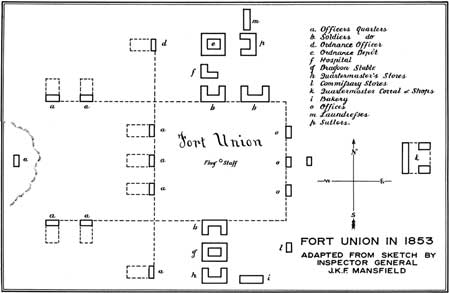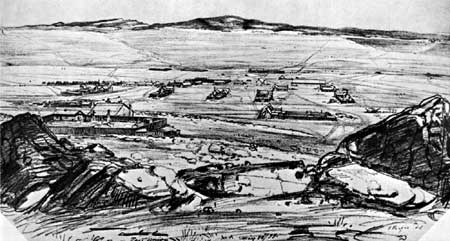|
FORT UNION National Monument |
 |
The Founding of Fort Union
 Lt. Col. Edwin V. Sumner, 1st Dragoons, established Fort Union in 1851. This picture was taken about 12 years later, after he had risen to the rank of major general. U.S. Signal Corps photo (Brady Collection), National Archives. |
With the acquisition of New Mexico, the United States inherited an Indian problem of frightening magnitude. For two and a half centuries Apaches and Navajos had terrorized the Rio Grande settlements, and travelers who ventured beyond the eastern borders of the province courted death at the hands of Kiowas and Comanches. The promise so lightly given by General Kearny to protect the people from marauding Indians took 40 years to fulfill. By 1851 almost 1,300 soldiers served in the Territory of New Mexico, and during the 1850's the number rose steadily. They were scattered among 11 tiny outposts at settlements throughout the territory. The headquarters was Fort Marcy in Santa Fe.
Secretary of War C. M. Conrad was unhappy with the performance of the troops in New Mexico. They cost an immense amount of money and made no apparent progress toward solving the Indian problem. On April 1, 1851, he directed Lt. Col. Edwin V. Sumner, 1st Dragoons, to take command in New Mexico and "revise the whole system of defense." "It is believed," wrote Conrad for Sumner's guidance, "that material changes ought to be made . . . both with a view to a more efficient protection of that country and to a diminution of expense." One material change seemed evident. The Secretary believed that "both economy and efficiency of the service would be promoted by removing the troops out of the towns . . . and stationing them more toward the frontier, nearer the Indians."
Sumner followed these suggestions to the letter, breaking up the posts at villages all over New Mexico and founding new ones closer to the Indian country. His first action after taking command in July 1851 was to order department headquarters and the principal supply depot moved from Santa Fe, "that sink of vice and extravagance," to a spot on the eastern frontier of New Mexico. He had already chosen the location in the vicinity of the same prairie ponds where as Kearny's dragoon commander he had camped on August 12, 1846. The site was strategically situated near the junction of the Mountain and Cimarron Branches of the Santa Fe Trail, 100 miles from the demoralizing temptations of Santa Fe. It had wood, grass, and water. Next to a spring beneath the brow of a pinyon-clad mesa on the west side of the valley, the troops in August 1851 began building Fort Union.

(click on image for an enlargement in a new window)
Ordinarily, civilian artisans employed by the Quartermaster Department built the frontier posts. But in the spirit of Conrad's economy drive, Sumner discharged these men and put his soldiers to work on Fort Union. The 30 or more buildings that resulted were what might be expected of unskilled labor, as Assistant Surgeon Jonathan Letterman made unmistakably clear in October 1856:
The entire garrison covers a space of about eighty or more acres, and the buildings being of necessity, widely separated, causes the post to present more the appearance of a village, whose houses have been built with little regard to order, than a military post. Unseasoned, unhewn, and unbarked pine logs, placed upright in some and horizontally in other houses, have been used in the erection of the buildings, and as a necessary consequence are rapidly decaying. In many of the logs of the house I occupy, an ordinary sized nail will not hold, to such an extent has the timber decayed, although several feet above the ground. One set of the so-called barracks have lately been torn down to prevent any untoward accidents that were liable at any moment to happen from the falling of the building; and yet this building was erected in 1852.
The unbarked logs afford excellent hiding places for that annoying and disgusting insect the Cimex lectularius [bed bug], so common in this country, which it is by no means backward in taking advantage of, to the evident discomfort of those who occupy the buildings—the men almost universally sleeping in the open air when the weather will permit. The building at present used as a hospital, having a dirt roof, has not a room which remained dry during the rain in the latter part of September last, and I was obliged to use tents and canvas to protect the property from damage.
Despite the distressing picture of living conditions painted by Dr. Letterman and others, not until late in 1862 did the Army get around to authorizing construction of more habitable quarters. By then the log buildings were in such terrible disrepair that, for the health and safety of the garrison, they had to be torn down.
Even before completion of the fort, Colonel Sumner in January 1852 found it "indispensably necessary" to move his headquarters to Albuquerque, for most of the current Indian troubles were west of the Rio Grande. The troops at Fort Union were not left idle. Besides construction of the fort, economy required them to cultivate gardens and harvest as much of their subsistence as possible. They had also to take over the jobs formerly done by civilian clerks, blacksmiths, teamsters, herders, and road builders.
Throughout the 1850's only a handful of men garrisoned Fort Union, usually one to three companies of infantry, dragoons, or mounted riflemen. Since the fort at times served as the headquarters of a regiment, however, a full colonel could often be found as post commander. With all their housekeeping duties, it is surprising that the soldiers found time for soldiering. But somehow they managed to participate in several Indian campaigns and also to protect the Santa Fe Trail.

The first Fort Union. Joseph Heger sketched this
view from the bluffs to the west in 1859.
Arizona Pioneers Historical Society.

|
|
Last Modified: Sat, Sep 28 2002 10:00:00 pm PDT |


